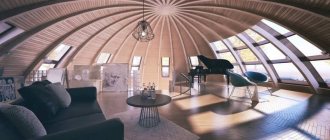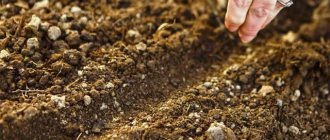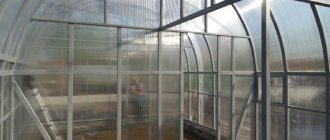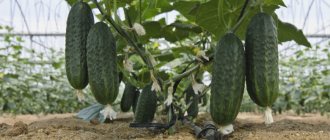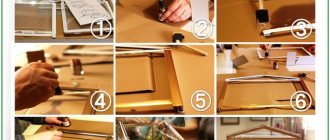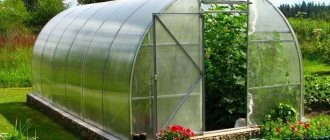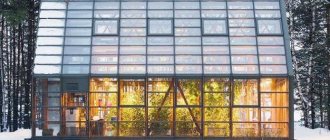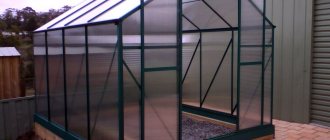For decades now, elegant glass structures have been confidently competing with greenhouses made from other materials. The article talks about glass greenhouses, the advantages and disadvantages of standard designs. The material contains information about the types, features and characteristics of glass greenhouses. You will learn about optimal materials and choice of location, and get acquainted with the criteria for choosing a finished model.
Dear painting Source dachnaya-zhizn.ru
Advantages
It’s a rare owner of a summer cottage who will refuse the pleasure of having fresh vegetables and fruits, only from the garden, for the table, and in winter enjoy home-canned food. Unfortunately, the future harvest depends on the whims of Mother Nature, and the climate in many regions is not conducive to growing heat-loving crops. The solution to the problem was glass greenhouses; The first such structures appeared in European countries a couple of centuries ago.
With the development of technology, not only glass, but also other materials (polycarbonate, film) began to be used for the construction of greenhouses. Despite the alternatives, glass greenhouses still adorn suburban areas. The reason for its sustained popularity is not the conservatism of the owners, but the properties of glass structures, which ensure a stable harvest. The advantages of glass structures are the following qualities:
- Transparency . Glass transmits sunlight better than other materials, so you can make the most of natural light. Transparency does not decrease over time, unlike, for example, some types of polycarbonate, which become cloudy under the influence of ultraviolet radiation.
Everything is in full view Source checkfrank.be
- Chemical inertness . When caring for vegetables and herbs, amateur gardeners use fertilizers, pesticides and other compounds (both acidic and alkaline). The glass surface is impervious to any chemicals.
- Durability . Glass is indifferent to dampness, solar energy, temperature changes and mold fungi. The durability of a glass-clad structure depends only on the material from which the frame is made.
- Physical properties . Glass is resistant to abrasive effects (for example, scratching or sand blown by the wind). The material has a low thermal expansion rate, which makes construction easier.
- Easy care . Removing dirt from a glass surface is not a problem; The choice of detergents is not limited.
- Simple repair . It consists of easy replacement of the damaged fragment.
- Aesthetics . Glass buildings are distinguished by their grace and attractive appearance.
- Possibility of savings . You can significantly reduce the cost of construction if you use old windows or doors.
Solution for a modest site Source www.gardensite.co.uk
Photo
In the photographs provided, you can see other options for greenhouses made of glass:
Large glass greenhouse
Compact glass greenhouse
Small glass greenhouse
Construction of a glass greenhouse
Homemade greenhouse from window frames
Ready-made greenhouse from window frames
Hexagonal glass greenhouse
Greenhouse for flowers
Made of glass and matelloprofile
With windows
Double-glazed construction
Flaws
Many owners of summer cottages prefer a traditional glass greenhouse, which can provide an optimal microclimate for vegetables, seedlings or herbs. When choosing this or that material for a future greenhouse, do not forget about the disadvantages of the coating. The disadvantages of glass cladding include the following qualities:
- Fragility . The main disadvantage that stops many owners. Hail, a fallen branch or a child's ball can cause serious damage to a structure. Using tempered glass will protect against such problems, but will increase the construction budget to an indecent size (tempered glass is about twice as expensive as regular glass).
- Price . Glass is a very heavy material that requires a particularly strong frame and a reinforced (and therefore more expensive) foundation. This means that the final price of a glass structure will be higher than a polycarbonate greenhouse with similar parameters.
- Low thermal insulation . Glass has a higher thermal conductivity than polycarbonate. If the building will be used during the cold season, a well-thought-out heating system will be needed.
A gardener's dream Source sincv.info
Construction stages
The construction of glass greenhouses goes through the following stages:
- After choosing a project, a drawing is drawn up . The type of foundation and materials are also agreed upon.
Economical and prefabricated turnkey option from teplici-lux Source teplici-lux
- The dimensions of the structure are being specified . The height is the sum of the heights of the base, wall and roof. The length of the building is the sum of the width of each frame pillar and glazing fragment.
- The foundation is being built . When it dries and gets stronger, a base is built.
- The frame and roof are being erected.
- The walls and roof are being glazed ; the material is fixed from bottom to top.
- Doors and windows are attached.
Varieties
Glass greenhouses can have the following shape:
- Greenhouse-house . The classic, most common option with a rectangular base and a gable roof. This design fits into any environment. It is the most convenient to use, not the most difficult to build, and the slope of the roof prevents snow from accumulating.
- Wall-mounted . A structure that is attached to the wall of a house or utility room and is considered very economical. Such a greenhouse saves owners building materials and square meters, which is important for a modest-sized plot. Such glass projects are usually equipped with a pitched, sloping roof. It is advisable to choose a location on the south side so that seedlings and vegetables do not suffer from a lack of life-giving solar energy.
Wall-mounted greenhouse Source dacha.help
See also: Catalog of companies that specialize in the installation of metal structures.
- Mitlider's greenhouse . A variation of the classic greenhouse-house, invented by an American vegetable grower. The difference lies in the structure of the roof: One of the slopes is laid higher than the second, forming a vertical section. Transoms are mounted in this wall, ensuring effective air exchange.
Mitlider's greenhouse Source teplicno.ru
- Greenhouse thermos . Most of the structure consists of walls made of brick or concrete, the roof remains glass, and the structure itself is buried in the ground. Heat loss becomes minimal, making it ideal for winter use. The downside is high material and labor costs during construction.
Trench greenhouse Source fermer.ru
- Pyramidal . More complex in design and execution, therefore it is quite rare, although it has an impressive appearance. Contrary to popular belief, it is quite easy to use; Most often used for ornamental crops.
- Dome . Thanks to its streamlined shape, it is characterized by increased stability and the most uniform distribution of solar energy. The big minus is that an accurate design calculation is required; the frame will be complex, and the glazing details will be non-standard.
Original domed greenhouse Source pinterest.com
What is a greenhouse and how is it different from a greenhouse?
Greenhouse - construction of protected soil for growing seedlings, vegetable, fruit and ornamental crops, as well as propagation and preservation of tropical and subtropical plants, conducting biological research, etc.; a room covered with glass or transparent film and plastic. Heating of greenhouses - solar, biological (heat of biofuel), technical (water, steam, electric). Winter greenhouses are in use all year round, spring greenhouses - in spring, summer and autumn; There are soil and hydroponic greenhouses (growing in artificial environments without soil).
encyclopedic Dictionary
https://www.slovar.plib.ru/dictionary/d5/61781.html
The structure of a greenhouse and a greenhouse are similar. Their design consists of frames that form the base and a coating that protects plants from low temperatures by transmitting the necessary ultraviolet radiation. But there is an obvious difference.
The greenhouse is designed to protect beds in open ground. It can be long or short, but always of small height. The most common form of a greenhouse is semicircular: a structure made of metal or plastic pipes bent in arcs on a wooden base. But often the arcs are installed directly into the ground. To cover a greenhouse, as a rule, light polyethylene film is used. If necessary - when it’s warm, or you need to weed, dig up, hill up - it simply folds back.
Long greenhouses made of metal arcs can be installed in endless rows
A greenhouse is a construction of a completely different engineering level. Although the simplest greenhouses in everyday life are sometimes called greenhouses, this is not entirely true. The frame of this design is more complex and is made from more expensive and durable materials. It uses wood, metal profiles of various types, plastic pipes in a wide variety: polyethylene, polypropylene, polyvinyl chloride and metal-plastic reinforced with fiberglass. You can enter a tall greenhouse at full height and work without any restrictions. The structure is equipped with a door (or two opposite each other), windows, and sometimes vents. The greenhouse can be installed on open ground, or it can be designed like a house, with a paved stone floor, where racks for flower pots and pallets for seedlings are arranged.
It is also covered with more expensive material than a greenhouse. It is not simple polyethylene film that is used, but reinforced for strength or bubble film, which is warmer, but transmits ultraviolet radiation less well. Equally transparent non-woven materials of all types are also used. A very popular coating is cellular polycarbonate sheets. But if you want to build a beautiful all-season greenhouse, glass mounted on a solid frame is suitable for this.
Photo gallery: types of greenhouses
A greenhouse can be built from double-glazed windows
Greenhouse made of aluminum profile covered with polycarbonate
The design of a wall-mounted glass greenhouse allows you to save on an extra wall and provides additional heat
Wall greenhouses can be of different configurations
You can create a greenhouse of unusual shape from wooden planks
Plastic pipes and polycarbonate are common materials for greenhouses
Glass will help maintain a comfortable microclimate in the winter garden
The frame for a glass greenhouse can be aluminum frames
You can build a greenhouse with your own hands from old wooden window frames
Using wood and glass you can build a large original greenhouse
A greenhouse made of colored glass will become an unusual decoration of the site
Greenhouse made from plastic bottles - a simple and economical option
Materials and optimal parameters
Glass greenhouses can have the following frame options:
- From metal corners . The corners are welded to each other, forming a durable structure that can withstand strong wind and snow loads. Glass elements are secured using clamps.
- Metallic profile . The frame parts form grooves in which glass plates are installed. The strength and tightness of the fastening is ensured by seals made of high-quality rubber and sealant.
- Reinforced wooden frame . To withstand weather loads and the weight of glass, the frame is equipped with reinforcement elements (jibs). This solution makes the structure more stable in strong gusts of wind.
- Galvanized profiled pipe . The frame system parts are secured in two ways: welding or using self-tapping screws. Glass plates are attached with glue or using a clamping profile.
- Plastic . Must be strong enough to support the weight of the glass.
Lighting
Due to its capital size, the greenhouse will be used all year round. In winter there are short daylight hours, so plants will definitely need bright, full lighting. As elsewhere in our everyday life, it will be more economical and reliable to install LED lamps. In addition, such systems are equipped with an automatic adjustment system: they are easier to control so that they turn on and off at a certain time without human intervention. Timers were invented for this.
LED lighting can be controlled using a timer
Selecting a location
A warm glass greenhouse is an indispensable assistant in growing much-loved tomatoes, cucumbers and peppers. To get an excellent harvest, it is not enough to use the right agricultural technology. For a high-quality result, the placement of the greenhouse is important, so the location is chosen carefully, taking into account the following factors:
- Location . A place is selected away from other buildings and trees that can create unnecessary shadow for greenhouse crops.
- On a modest-sized plot, the choice of location is limited. In this case, the greenhouse is placed south of the building so that the maximum amount of sunlight falls on it.
- The structure should not be located on a slope , where there is a high probability of additional stress and damage to the foundation.
- When choosing a location, take into account the wind rose - in a draft, the glass surface cools faster, and the temperature inside does not reach the optimal temperature.
- Convenience . Proximity to water, easy access and the ability to connect to the power grid are important.
- In a region with frequent gusty winds, the frame and foundation are strengthened ; They also try to build the greenhouse away from tall trees so that a falling branch does not break the glass.
Pouring the foundation
So, you have chosen a suitable place to build a greenhouse and, using drawings, calculated its dimensions. Now, using pegs and rope, you can mark out the area for construction.
Trench for the foundation
Let's move on to the crucial moment - laying the foundation of the greenhouse. It should be noted that with a properly poured foundation, you can save up to 10% of heat in winter.
Experts recommend the use of a strip foundation, which ensures the strength of the structure. In this case, concrete is poured to the depth of soil freezing (from 55 to 80 cm).
How to pour a foundation for a glass greenhouse?
- Dig a trench 30 cm wide and 40 cm deep.
- Next, pour sand into it, which needs to be compacted.
- Place reinforcement into the trench to strengthen it and fill it with concrete.
Erect a plinth 10 cm high above the foundation, while increasing the formwork. Using a level, level the top of the formwork and refill the concrete layer to the edges. To create waterproofing, lay a narrow strip of roofing felt or bitumen mastic on the hardened concrete. Now make brickwork to the height of ½ brick at the base of the frame. You can slightly change the process of pouring the foundation, however, the principle remains the same - the use of embedded reinforcement and waterproofing material.
The foundation should be additionally insulated on all sides with polystyrene foam boards.
What to look for when choosing (ordering)
It doesn't matter whether you choose a ready-made greenhouse or order a custom design, there are nuances that allow you to make the best choice; the following factors are taken into account:
- Greenhouse dimensions . For a good harvest, vegetables and herbs must have enough space and receive enough sun.
- Frame . The service life of the greenhouse depends on how well the fastenings are tightened and how tightly the glass and vents fit to the frame.
- Frame protection . It is good if the profile is powder coated. This painting method is environmentally friendly, protects the metal from atmospheric moisture and improves its appearance.
- Glass . It can be simple or hardened, but the thickness is limited - at least 4 mm. The use of tempered glass in greenhouse construction has advantages: it is 3-4 times stronger, and when the critical load is reached, it is less dangerous because it crumbles into small, non-sharp pieces.
- Sealant . A high-quality seal eliminates vibration of glass elements in windy weather and prevents water from flowing inside.
Ventilation system Source kachestvolife.club
- Check if the greenhouse has a sufficiently convenient entrance .
- Windows . An important element of a professionally built greenhouse. Many plants cannot tolerate overheating, and windows or transoms will allow you to flexibly regulate the microclimate.
The design of greenhouses sometimes contains elements of functional decor, for example, a ridge or a drainage system. Some greenhouse models are equipped with additional elements that make caring for plants more comfortable. Useful devices include:
- Microclimate automation . A useful accessory for those who cannot live outside the city permanently, but are forced to periodically leave (for work or on vacation). The automatic system includes a thermal drive that prevents the air from overheating, opening the transoms when the temperature rises. Constant air exchange protects garden crops from dehydration and wilting. If the temperature drops in the evening, the vents are closed, and the desired level of heat is maintained in the room.
How to care for a glass greenhouse
Careful adherence to the rules of care is a guarantee of maintaining the aesthetic properties of the greenhouse for a long time:
- It is recommended to wash glass with the same products that are used to clean home windows.
- In places where condensation forms and favorable conditions are created for the growth of microflora (for example, in corners), it is recommended to use an antiseptic for disinfection.
- Carefully care for the wood, remove scratches, and do not forget to paint regularly.
- Closely monitor the tightness of the contacts of wooden and glass elements.
Proper operation of the structure will allow the latter to please the eye and bring benefits for decades.
Characteristics of standard models
The configuration of common models is described by the following parameters:
- Frame . Most often it consists of aluminum profile elements protected by polymer painting. There is also a steel profile with a zinc anti-corrosion coating. Since all parts of the greenhouse are reliably protected from moisture, it does not require maintenance (priming or painting) during operation.
- Filling (coating material). Regular or tempered glass, double glazing 32-60 mm thick.
- Foundation . The type of base is specified.
- Door . A sliding door of two leaves (sliding) or rotating (hinged) is installed. The door is insulated and filled with double glazing.
- Window , side, end, louvered, tilt-and-turn or sliding. At the customer's request, windows for ventilation are equipped with an automatic ventilation system.
- Sealing profile . The type and color (usually black or white) are determined. A high-quality rubber profile is the main condition for the tightness of the building and the preservation of an optimal microclimate.
A modern option with all the amenities Source pezcame.com
- Fastening elements , ebbs.
- Additional elements . At the owner's request, internal partitions and borders are installed to enclose the beds.
Planning the interior space
Once a suitable area has been selected, you can proceed to drawing up a diagram according to which the beds will be located inside the aluminum greenhouse:
- In 2 rows - the classic version, which assumes an entrance in the center of the structure. The width of the path is 65 cm, the beds are located on the sides and their size varies from 90 to 100 cm; if the indicators are increased, it will be much more difficult to care for the crops.
- In 3 rows - this option is great for wide buildings. In this case, two beds are located on the sides of the aluminum greenhouse, in the center of the structure there is an entrance and from it there are two paths, between which there is a third bed. Typically, the central bed is much wider than the other two. If necessary, a shelving unit can be placed in the center.
- U-shaped in 2 rows - if the greenhouse has beds on the sides and a path in the center, then on the opposite side of the entrance there is a “dead zone”. The disadvantage of this model is difficult access to plants growing in corners.
- The entrance to the greenhouse is from the side - with this design, the beds will be located around the perimeter of the entire aluminum greenhouse. A special feature is the efficient use of available space. However, it is worth considering that such a scheme is not suitable for an arched model.
- An entrance on the side of the greenhouse with a dressing room - this arrangement option is perfect for winter greenhouses, thanks to which you can prevent a draft when entering the greenhouse.
If you choose the right layout of the beds, you can use the greenhouse area to the maximum.
Attention! It is important to understand that in the presence of drafts, diseases in seedlings cannot be avoided.
Design Features
How to build a smart greenhouse according to Kurdyumov with your own hands?
Despite the fact that most manufacturers and suppliers offer their clients to install one or another greenhouse, it is quite possible to install a plastic greenhouse with your own hands. You can also purchase its individual components, for example, a PVC profile, plastic polycarbonate parts, fiberglass reinforcement parts, necessary screws, etc. All this can be done depending on how convenient it is for you, for example, if you purchase a greenhouse in the winter and plan to install it in the summer.
If you purchase goods from some trusted supplier of greenhouses or fiberglass fittings, then it is better to do so in full. In other words, purchase the profile itself, polycarbonate, hooks, various corners, and self-tapping screws. Here you have a fairly wide choice and the largest number of different functions and options. By purchasing ready-made polypropylene greenhouses, you can choose a variety of sizes and shapes.
Installation and Installation
A metal-plastic greenhouse does not like temperature changes, since the plastic begins to bend and deform. The same applies to too high a temperature. For example, if you install a greenhouse in the summer, then when exposed to warm air, the plastic begins to expand. As a result, you may notice allowances and extra holes between joints. In this case, the polypropylene greenhouse needs additional sealing.
The optimal temperature at which experts advise installing various types of greenhouses, including plastic greenhouses, and at which they most often operate, is 10-12 °C. Accordingly, if you install the structure in winter or summer, then temperature differences can reach 20 °C. This is not recommended to avoid unnecessary work that will be required to fill the resulting holes or correct plastic structures, for example, a greenhouse made of fiberglass base. A plastic greenhouse retains heat inside best.
How to attach a greenhouse
Today's market offers a huge number of greenhouse bases. It is necessary to make the right choice of PVC greenhouse. There are the following varieties: mounting on a foundation and mounting on ordinary soil.
When choosing 1 type of structure, you need to pay attention to how the arcs are attached to the base. So, for example, in this case it is necessary to consider all the ways of attaching them to the base
Here you can find so-called nickels - parts at the bottom near the foundation. There are designs in which the arc is attached to the base using anchor bolts.
If you intend to install greenhouses not on the foundation, but on the ground, then the choice of both materials and tools will be much wider. For example, you can purchase arches that end with a long pin at the bottom. It simply digs into the ground to a certain depth. Another variety are those that end with a part in the form of an inverted letter T. In this case, they are dug into the ground, just like the first ones.
The second option is of higher quality and provides more reliable adhesion of the greenhouse to the ground. But there is one more option, which experts recommend using in most cases. These are structures in which there is a solid, durable frame around the base of the greenhouse. At the bottom of the arcs there is a single base, on which special parts are welded, which can be attached both to the ground and to the foundation. These parts have the shape of a loop, and in the case when you are going to attach a greenhouse made of fiberglass reinforcement to the ground, long pins are inserted into these loops, which are driven into the ground approximately 80% of its length.
At the same time, it is worth paying attention to the fact that it is not worth driving the piles completely into the ground. This is done so that over time, when the soil settles or some other changes occur to it, you do not have a situation in which the piles come out of their loops
Indeed, in this case they will not be able to perform their functions and ensure reliable adhesion of the greenhouse to the ground.
Building made of glass or polycarbonate: which is better?
Polycarbonate is a durable, non-fragile polymer plastic. To cover greenhouses, cellular or cellular polycarbonate is most often used:
Cellular polycarbonate sheets
The material consists of 2 layers, which are fastened together by a large number of internal stiffeners. Between the layers there is air, which can give the material high thermal insulation properties. Stiffening ribs make polycarbonate resistant to mechanical damage.
The main advantages of polycarbonate over glass:
- High strength.
- Good thermal insulation. If you plan to use the greenhouse all year round, then it is recommended to use this material.
- Minimum time spent on maintenance.
- Light weight.
- Easy to install.
- Flexibility of the material.
- Low cost.
Disadvantages of the material:
- It is recommended to entrust the installation of a polycarbonate greenhouse to specialists. You can fix the material yourself, but it will take a lot of time.
- In winter, the weight of snow can cause polycarbonate to bend or fold.
- The material is significantly inferior to glass in terms of light transmission.
- The service life is several times lower than that of glass.
- Average chemical resistance.
Advantages of glass over polycarbonate:
- The material does not change its properties and appearance.
- Has a long service life.
- Resistant to chemicals.
- Ease of maintenance.
- During the heating process, the glass will not emit any unpleasant odor or harmful substances.
- Easy to replace if damaged.
A table of material characteristics will help you make the comparison:
| Material characteristic values | Glass | Cellular polycarbonate |
| Service period | Up to 50 years | Minimum 10 years |
| Weight, kg/m2 | 10 | 1,3 |
| Transparency, % | 92 | 86 |
| Thermal insulation characteristics, W/m2 x ºС | 185 | 8 |
| Thermal conductivity, W/m2 x ºС | 0,8–0,9 | 0,14 |
| Fire safety | Low fire level | Difficult to ignite |
| Chemical resistance level | High | Average |
| Material cost | High | Low |
| Ease of installation | Requires caution | Easy to cut, drill and install |
The choice must be made based on needs and financial capabilities.
